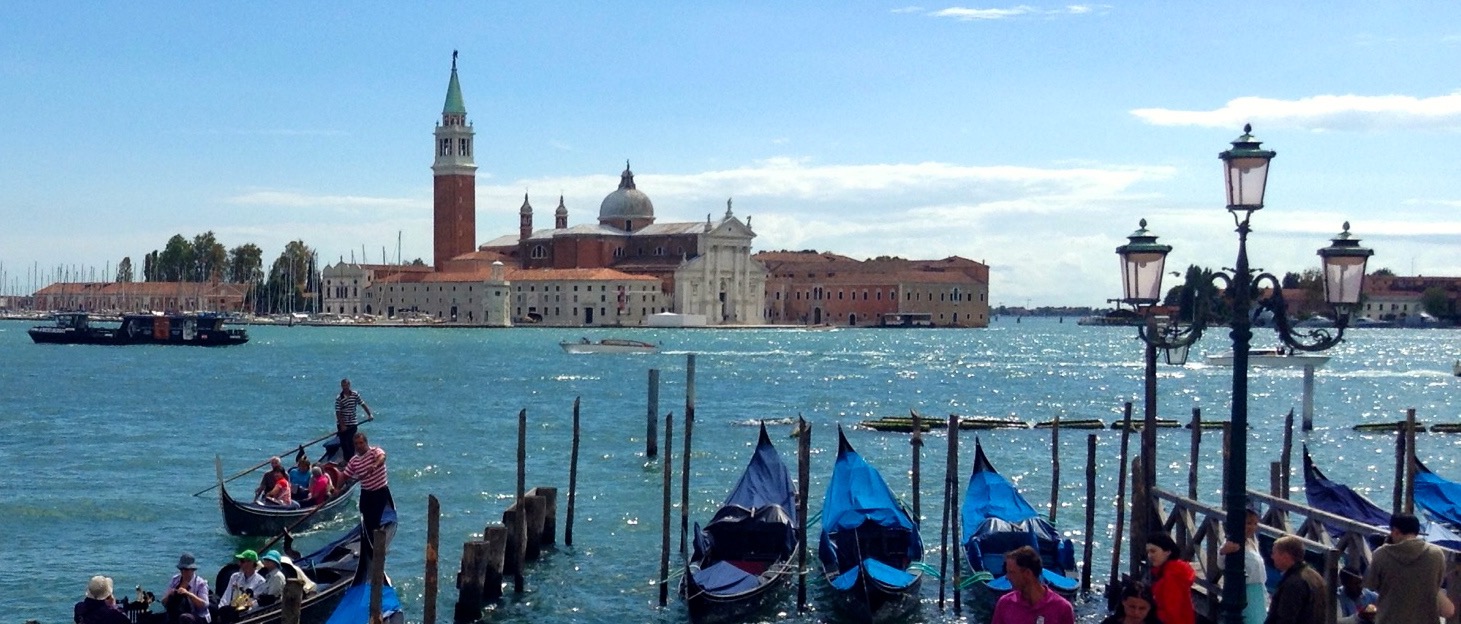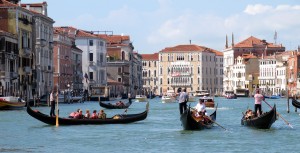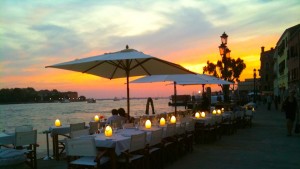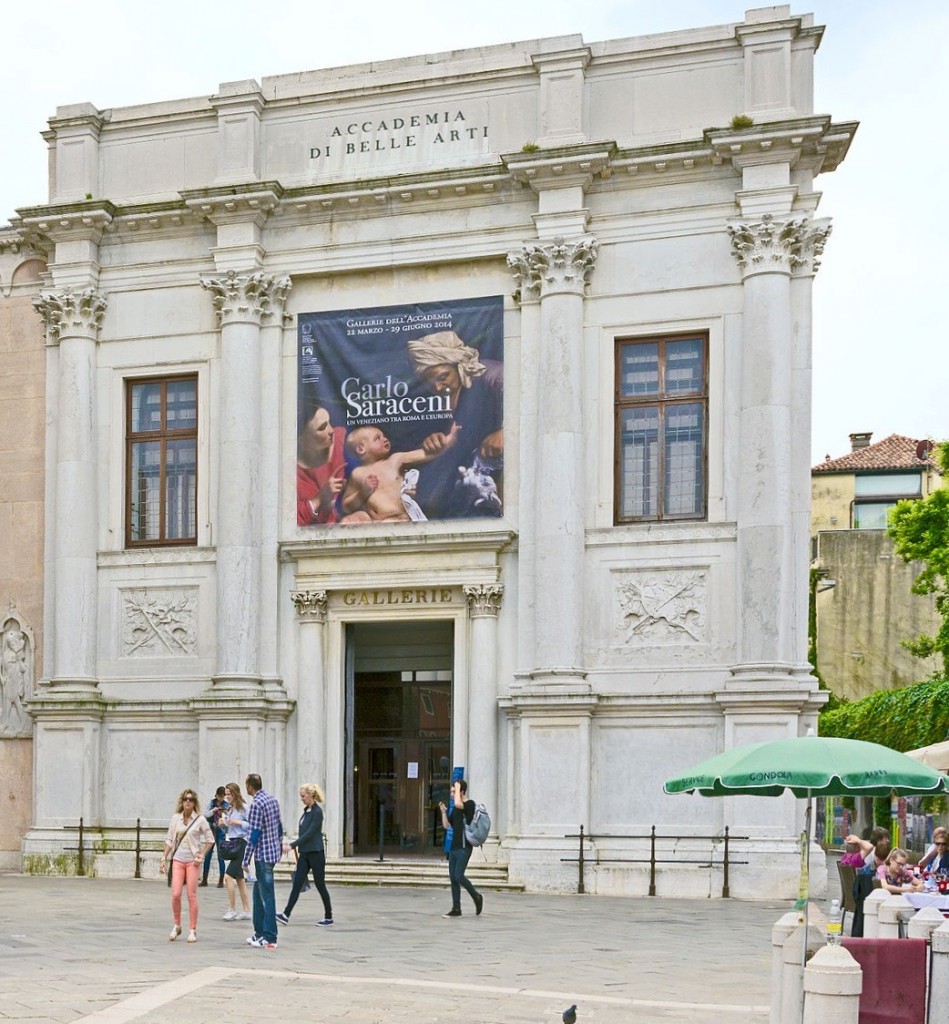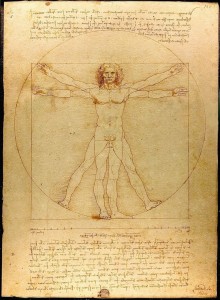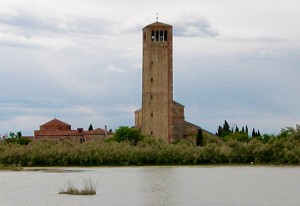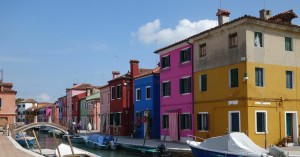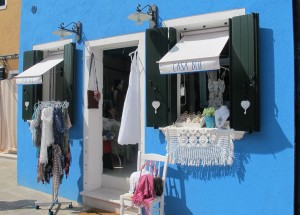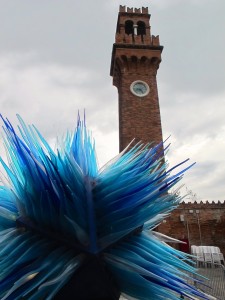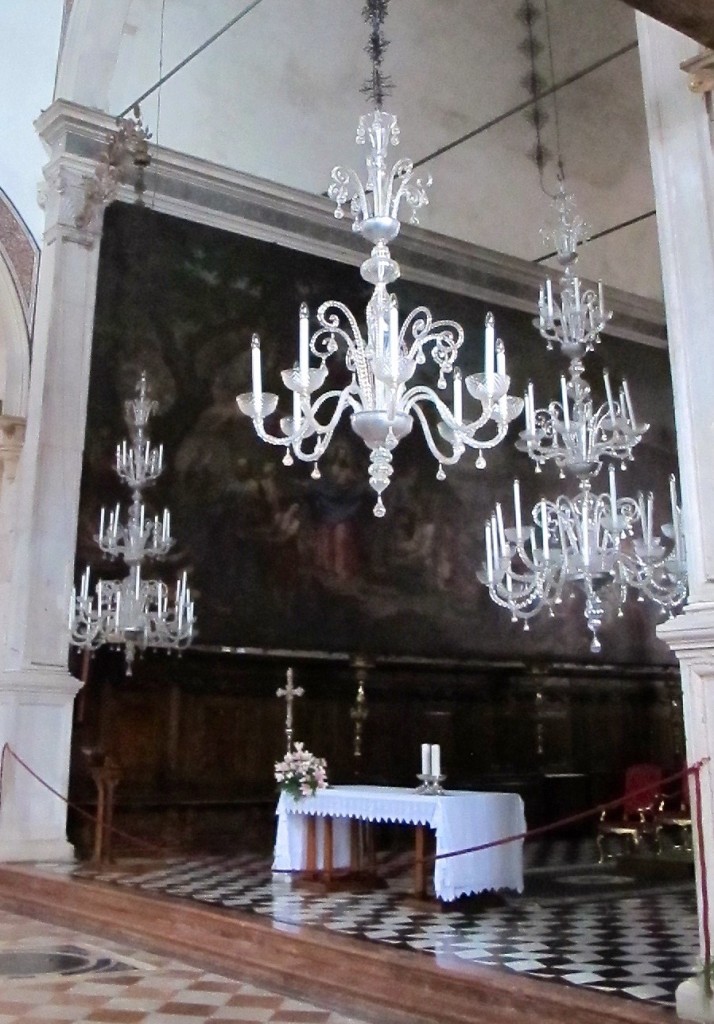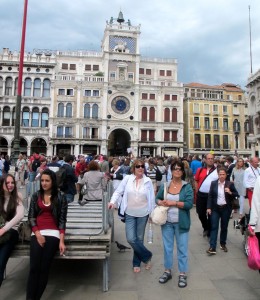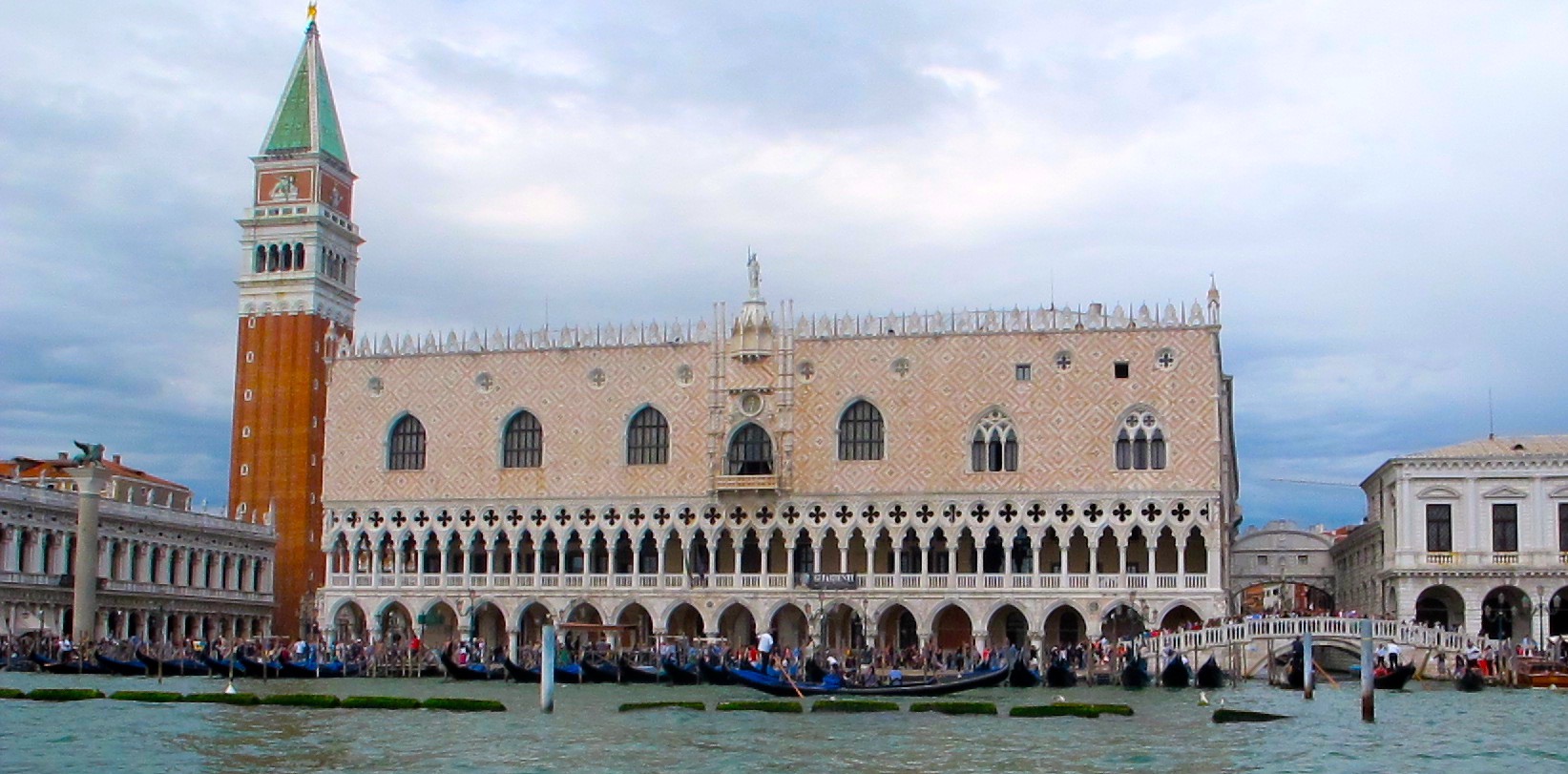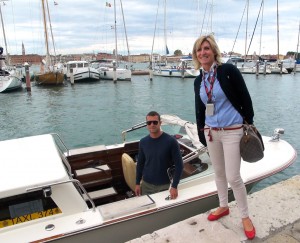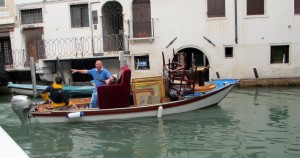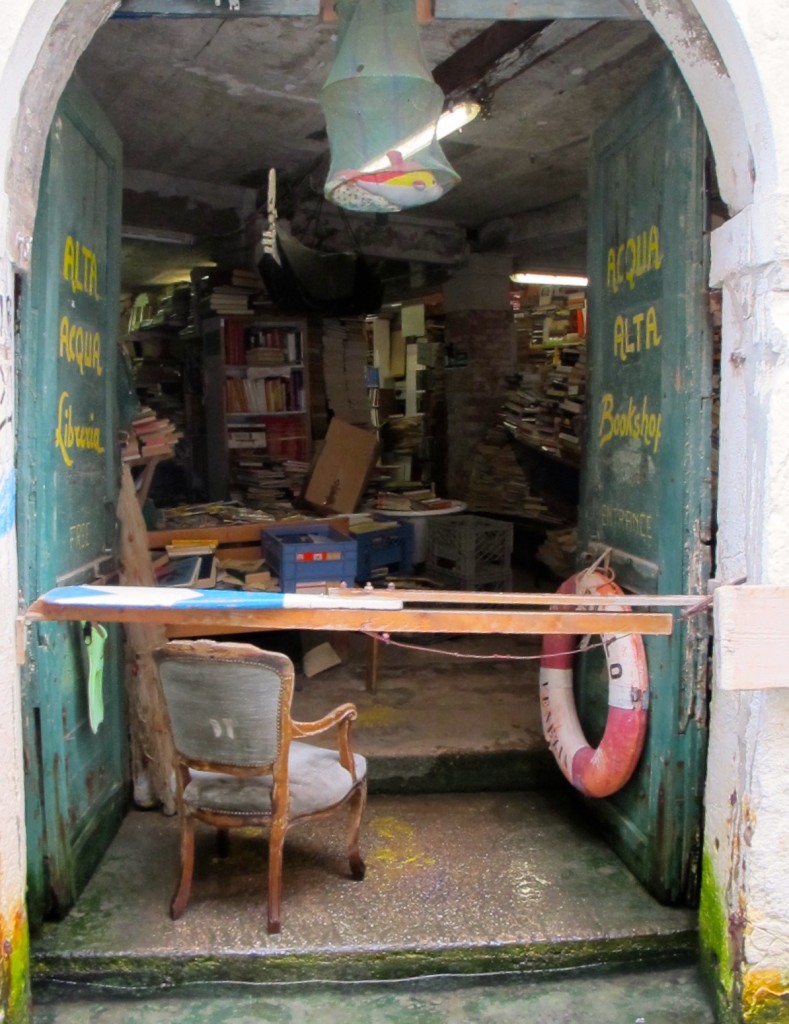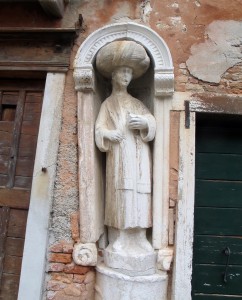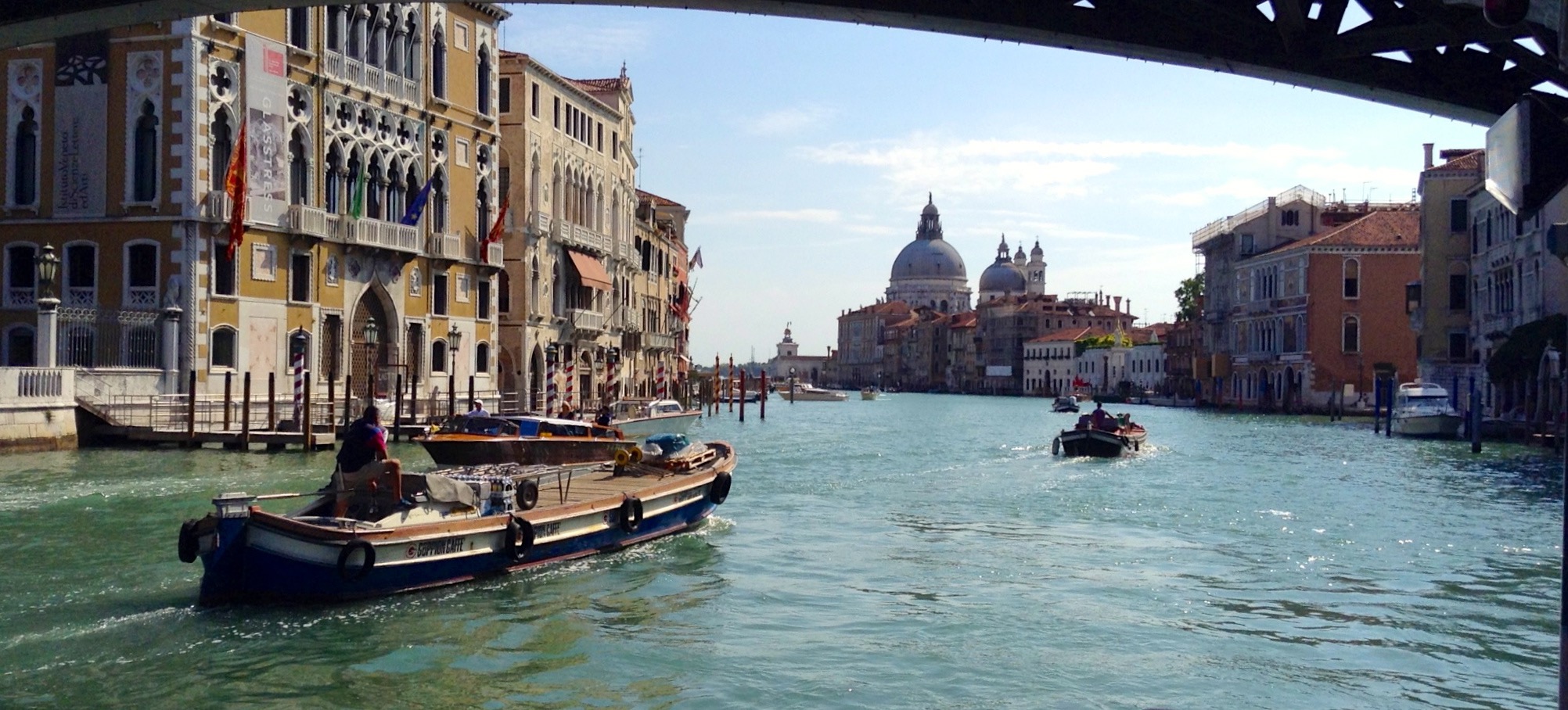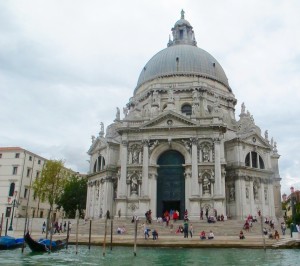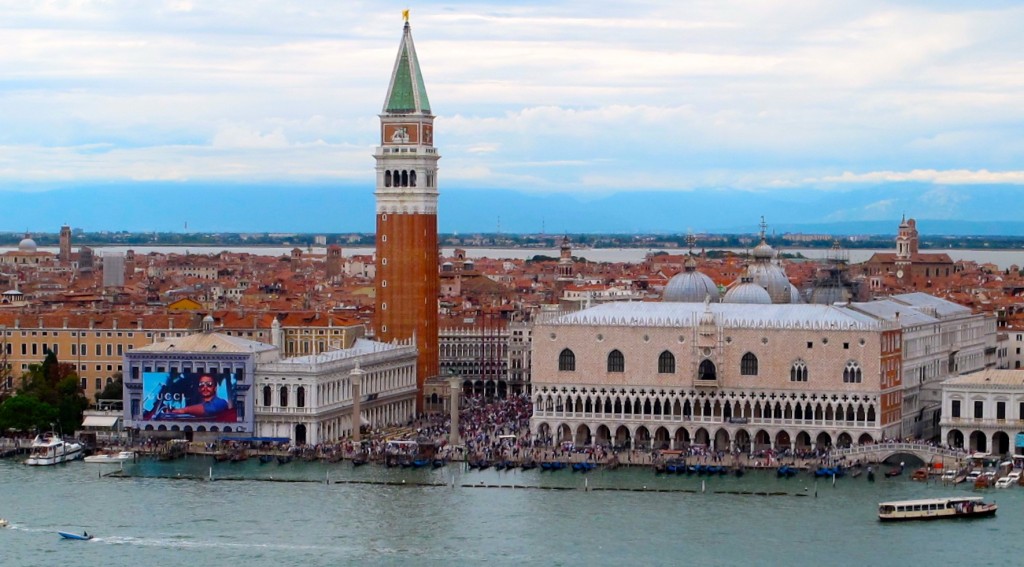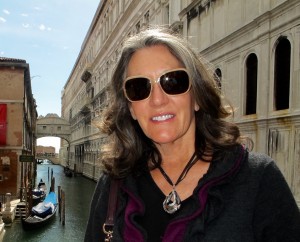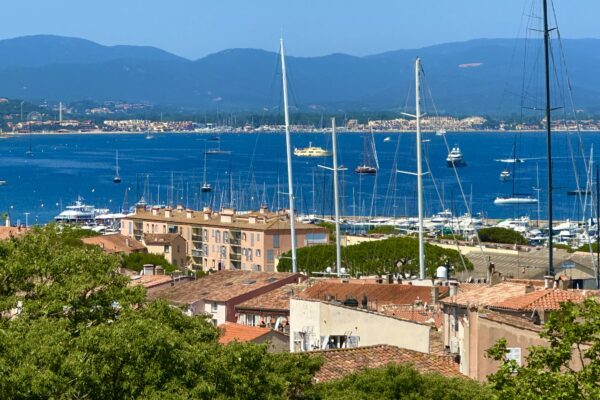La Serenissima’s Schizophrenia
by Marla Norman, Publisher
Spend some time in Venice and you quickly realize La Serenissima has an acute case of schizophrenia. By day, she’s cranky — even downright mean. Her ancient piazzas are packed with tourists, over 60,000 of them daily, more than the total population of the city itself. Gondolas, vaporettos and motoscafos zoom along the canals, scarcely avoiding collisions with one another.
Moreover, the harsh light of day betrays the lady’s age. Centuries spent on the water have lined her delicate features with wrinkles and cracks — in spite of the fact that monumental renovation projects are constantly being initiated. But in the end, it’s being loved — so dearly — that takes the greatest toll.
Is it possible to enjoy this living treasure among so many other Venice-lovers? And can a visit be made without leaving too large a footprint?
Walk the streets at night and you’ll discover that Venice becomes another personality. Once the cruise ships and day tourists leave, the piazzas are almost deserted. Buildings are bathed in soft moonlight. Chandeliers blaze within arched terraces and resplendent salons. The waterways glisten, while slender boats quietly slide by and disappear up dark canals.
There’s a tranquility and grace about Venice at night. The decay, so visible a few hours earlier, is replaced with a majestic, graceful presence — some kind of magical revival, whereby the great lady regains her poise, smoothes her elegant gown and descends into her water kingdom. By night La Serenissima once again rules the seas in grand fashion.
GRAB THAT VAPORETTO!
Flying over Venice provides immediate prospective. This gem of the Adriatic is tiny and fragile — resembling an intricately-woven piece of baroque lace floating on the water. More the wonder that this wispy collection of islands has survived for centuries, much less dominated European seas and trade routes for hundreds of years. At the end of the 15th century, with 180,000 inhabitants, Venice was the wealthiest city in the world and the second most-populated city in Europe — only Paris was larger. The territory of the mighty Republic of Venice included over 2.1 million inhabitants.
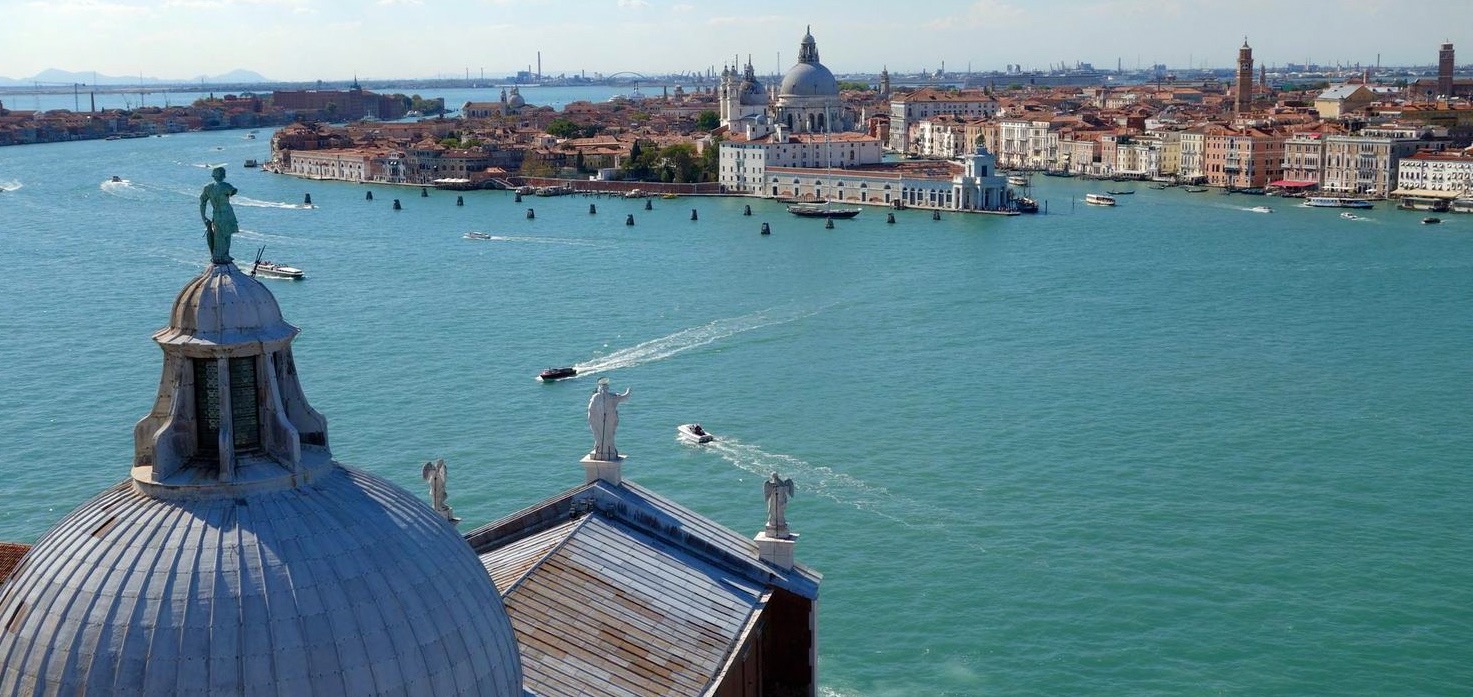
Venice resembles an intricately-woven piece of baroque lace floating on the water. Photo by Marla Norman.
Landing in Marco Polo Airport, we collect our bags and load onto a bus for Piazzale Roma — Venice’s transportation hub and the last stop for all buses, cars, and trains. From here on in, only water transportation can be used. We compete with hordes of other tourists to board vaporettos. For me, the word vaporetto has always conjured up romantic visions of sleek speed boats that move effortlessly through the Venetian canals — like a vapor of mist. In reality, the vaporettos are anything but speedy. They’re big, slow water buses — unglamorous, almost ugly — but the primary means of transportation around Venice.
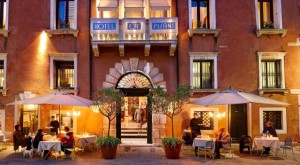
The Hotel Ca’ Pisani sits in a quiet residential area within the Dorsoduro. Photo courtesy of Ca’ Pisani.
Eventually we arrive at our stop: Accademia and the Dorsoduro Sestieri, one of the six districts in Venice. We drag our suitcases a couple of blocks. Then something strange happens — it’s quiet. The streets are practically empty. We’re certain we’ve taken a wrong turn when, suddenly, we spot our hotel. The Ca’ Pisani sits in a pretty residential area within the Dorsoduro. We check in and congratulate ourselves on escaping the crowds.
IL DOLCE FAR NIENTE
“No galleries, no museums, no monuments.” I make this pronouncement while soaking my aching feet in our room at the Ca’ Pisani. I’ve decided that the rest of the day will be devoted to il dolce far niente — an Italian phrase famously translated as the sweetness of doing nothing.
So we leisurely stroll along the walkways of the Dorsoduro, peeking into local shops: pasticcerias filled with heavenly smelling bread and torts; enoteches with tasty Veneto wines; shoe shops; flower shops; vegetable stalls — and no tourists! We cross dozens of cute little bridges leading over canals. The second we hear a language other than Italian, we immediately walk in the opposite direction.
A banner for a special exhibit of Da Vinci drawings at the Gallerie dell’ Accademia — Venice’s largest art museum — catches our attention and proves to be irresistible. We jump back on the tourist circuit for a couple of hours, however, we encounter only small groups of art enthusiasts. The superb collection of Tintorettos, Bellinis, and Carpachios — in addition to the Da Vinci drawings — is well worth seeing.
Exiting the museum, we realize we’re famished. A few blocks back into the Dorsodura, we run across a little cafe with delicious smells wafting from the kitchen. Collapsing under an umbrella set out on the sunny terrace, we order salads, pasta and a bottle of wine. Then we sit, nibble, sip and sit some more….ahhhh… il dolce far niente…
ISLAND HOPPING: TORCELLO, BURANO, MAZZORBO & MURANO
Some 1,500 years ago, Torcello was the original settlement within Venice. Here, the early Venetians built ingenious houses set up on pillars. The lagoons served to protect them from their enemies. Unfortunately, by the 12th Century, the lagoon around the Torcello began to fill in. Worse yet, the island was hit with malaria and ultimately the inhabitants fled altogether. Palaces were dismantled and their stones used for buildings in Venice.
All that remains now is the hauntingly beautiful Santa Maria Assunta Cathedral. Dating back to approximately 1185, the cathedral is filled with mosaics. The older mosaics are distinctly Byzantine — with stiff, rigid figures — while the newer pieces display a more-fluid Venetian style.
Also on the island is Locanda Cipriani, a restaurant and inn owned by the family of Arrigo Cipriani, the founder of Harry’s Bar. Guests have, not surprisingly, included Ernest Hemingway — who was also quite fond of Harry’s. The food is good, but diners love the tranquility of the lagoon, which is rarely visited by tourists.
Less frequented as well, is Burano. Cottages painted in bright, electric colors line the canals and provide a contrast to the white lacework for which the island is known. Visit the Museo del Merletto to learn the history of the art and to appreciate the effort required to produce lace. Leonardo Da Vinci visited in 1481 and purchased a cloth for the main altar of the Duomo di Milano. Soon after, Burano lace was in high demand all over Europe. Prices today for original pieces begin at around $1,000.00.
Wine lovers should make a point to visit Mazzorbo, home to the Venissa Vineyard. Monks originally established a monastery on the site, in the 5th Century. They also planted extensive gardens and a vineyard. Later, the monastery and grounds were abandoned and left unattended for decades. Recently, however, a few of the vines from the vineyard — the ancient native Venetian Dorona — have been discovered and painstakingly repropagated.
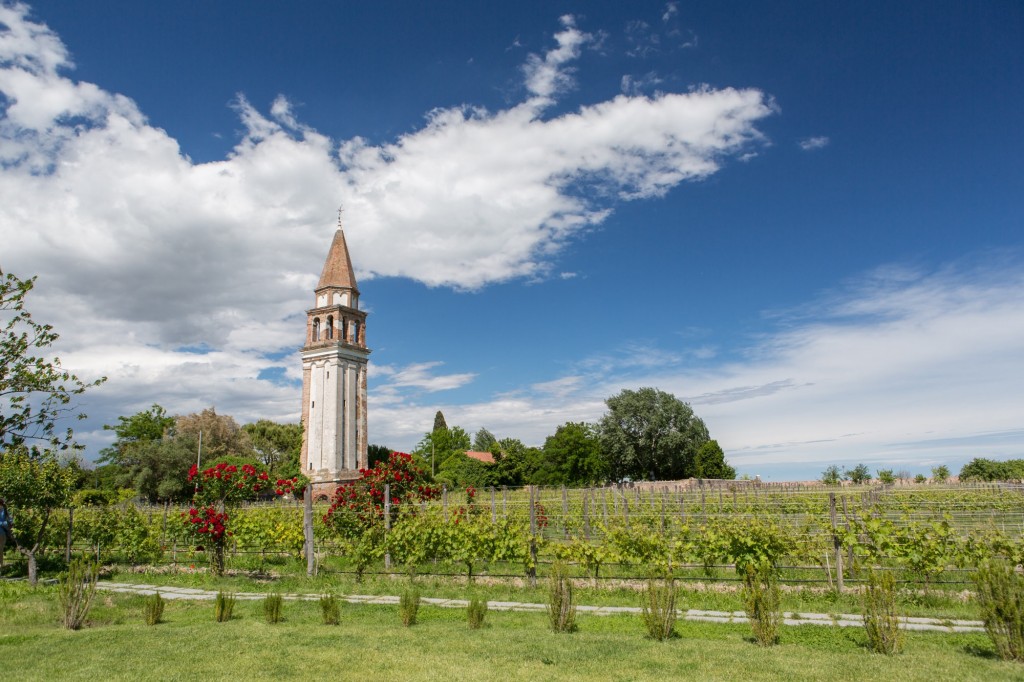
Venissa, an ancient vineyard in the middle of the Venetian Lagoon, was nearly extinct a few years ago. Photo courtesy of Venissa.
The Bisol family, producers of the prestigious Bisol and Jeio Proseccos for over 500 years, are now the proprietors at Venissa. The family is sponsoring projects to preserve both the ancient Venetian wine as well as other indigenous foods. Enjoy the wine and superbly prepared meals — breakfast, lunch and dinner — at the estate. Read more about Venissa in CURIOUS & THIRSTY.
Murano is easily the best-known of the Venetian archipelago and consequently visited more frequently by tourists. Since the 13th Century, Murano glassblowers have been admired around the world for their spectacular, ethereal creations. Visit the shops and factories to watch the artists produce beautiful glass chandeliers, plates, jewelry, etc. The Museo del Vetro presents an astounding collection of priceless antique Murano glass as well as contemporary exhibits.
Take a quick peak into Chiesa di San Pietro Martire. Two quite famous paintings are on display there: Giovanni Bellini’s Madonna and Child and Veronese’s St. Jerome.
CANNAREGIO, MADONNA OF THE VEGETABLE GARDEN & SAN GIORGIO MAGGIORE
With the exception of one beguiling, late night stroll, we’ve deliberately avoided Piazza San Marco — much like the ancient Venetians fled the Huns, Inquisition and Black Death. The famous square attracts thick crowds of tourists, so many in fact that even walking through the Piazza can be difficult.
Today, we’re braving the crowds to take a tour arranged through Walks of Italy. We’ve managed to make our way through the throngs at Piazza San Marco and are waiting for our guide at the Piazetta — the “little square” leading off San Marco to the open sea. We try to imagine the landing when it served as the grand entrance to the Republic of Venice. Its two towering columns — one topped by the winged lion, the second with Saint Theodore and his dragon — have become enduring symbols of Venice. The views from the landing — of San Giorgio Maggiore in the distance and gondolas in the foreground — are iconic images as well.
Meanwhile, the crowds continue to swell around us. The noise and circus atmosphere is formidable. Fortunately, our guide Cristina Pigozzo shows up promptly and whisks us off in a small motor boat. Out on the open water we breathe a sigh of relief.
We circle to the east of the Piazza San Marco for fantastic views of the Doge Palace.Then we cut back into tiny canals through Cannaregio. Venice’s largest Sestieri, Cannaregio consists primarily of working class families. Here, we get an inside look at local Venetians carrying on with their daily lives.
We hop off the boat briefly to explore Cannaregio’s old Jewish Ghetto. Cristina explains that the word “ghetto” actually originated from the Venetian word for “iron foundry” — an operation that existed long ago in the area. Five synagogues, considered to be some of the finest examples of Renaissance-era workmanship, are here. We also take a quick tour on foot of the old Moorish neighborhood: Campo dei Mori. Statues of Moors in elaborate turbans mark many of the buildings still today.
Back on the boat, we pass Acqua Alta, the oldest bookshop in Venice, as well as the homes of Venetian painters Tintoretto and Bellini. We also visit the pretty Madonna dell’Orto church, known for its late-Gothic façade. The church’s name is derived from a statue of the Virgin Mary by Giovanni De Santi that was initially considered too ugly to be included in the church. The Madonna was unceremoniously dumped into an adjacent vegetable garden. But miracles began to occur, so the homely Madonna was welcomed back and the church even renamed in her honor — Madonna of the Vegetable Garden.
From Cannaregio, we circle around to the Grand Canal and pass under the Rialto Bridge and Fish Market. Next up are the spectacular palaces that were built by the most prominent families in Venice from the 13th to 18th Centuries: Palazzi Barbaro, Ca’ d’ Oro — originally built entirely of gold, Ca’ Pesaro — now the home of the Galleria Internazzionale d’ Arte Moderna, the Gritti Palace — now a five-star hotel, and Palazzo Venier dei Leoni — which houses the Peggy Guggenheim Collection of Art. We travel slowly down the Grand Canal, taking in the views and stunning details.
To cap off our tour, we exit the Grand Canal and cross to the island of San Giorgio Maggiore. There we dock and visit the massive church, built in 1566. Two enormous Tintorettos decorate the interior, which is otherwise relatively unadorned: The Last Supper and Gathering of Manna. But the big attraction at San Giorgio Maggiore are the breathtaking views of Venice from the bell tower. And, best of all, because relatively few tourists visit the island, you can linger and enjoy the panoramic vistas for as long as you like.
CIAO VENICE
On our last night in the city, we meet friends for dinner at the Ristorante Riviera — read an interview with the restaurant’s owner, G.P. Cremonini in FOOD QUEST. We share our experiences and make more than a few toasts to the inimitable wonder that is Venice. Afterwards, we stroll through the quiet, deserted walkways. The night air has a distinct chill this evening and a strong breeze has blown away any trace of clouds, leaving hundreds of stars sprinkled in its wake across the sky.
A few wayward stars are still hanging out the following morning, when we board a motoscafo for a 6:00 flight out of Marco Polo Airport. The boat captain slowly starts the engine and we glide one last time through the canals of the Venetian water kingdom. The city is silent and peaceful so early in the day. Soft pink light breaks over the tops of buildings. Antique windows and tiles begin to glow and the water too takes on a golden shimmer. Venice at dawn is as irresistibly lovely as she is at night.
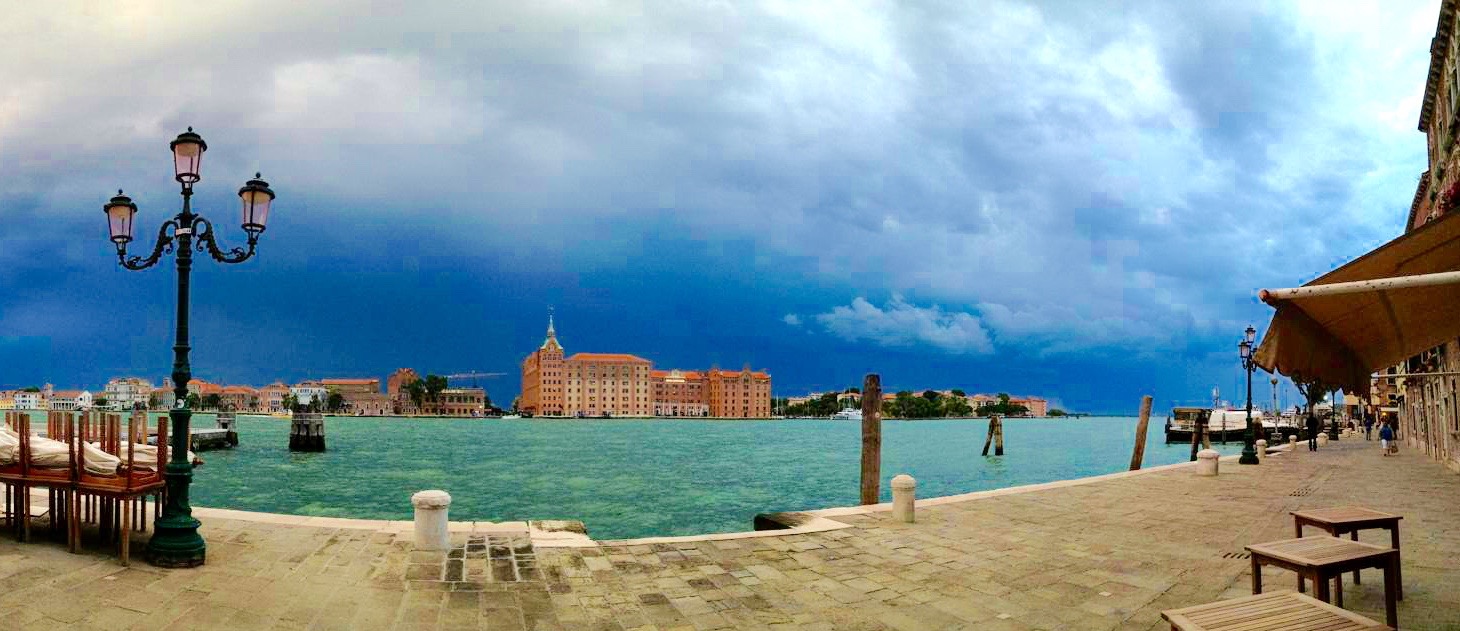
it’s impossible not to be enamored of Venice’s undeniable beauty and enduring history. Photo courtesy of Risotrante Riviera.
As the motoscafo reaches open ocean, the captain revs the engine. We pick up speed while Venice begins to fade in the distance. I strain to catch a last glimpse of La Serenissima and am surprised to feel a lump growing in my throat. But then it’s impossible not to be enamored of Venice’s undeniable beauty and enduring history — in spite of the daily circus that threatens to crush her. In the end, like so many other visitors, I feel a schizophrenic kind of love for the multiple personalities of this grand lady.
Click on the map pins for information about locations mentioned in the article.


